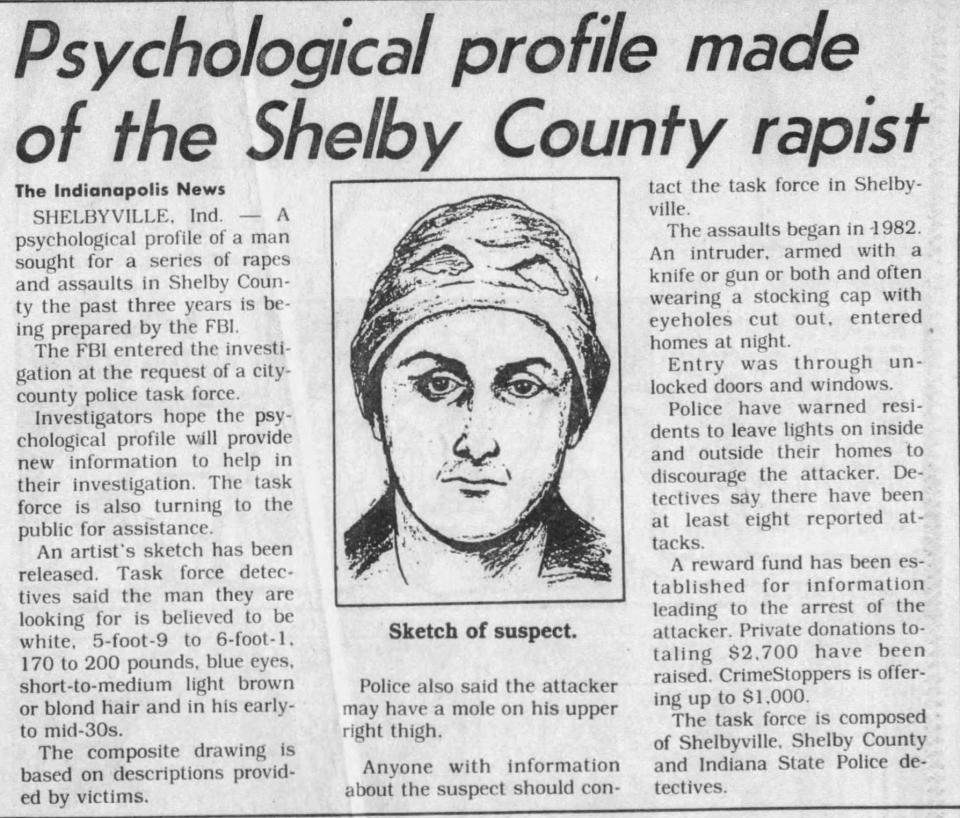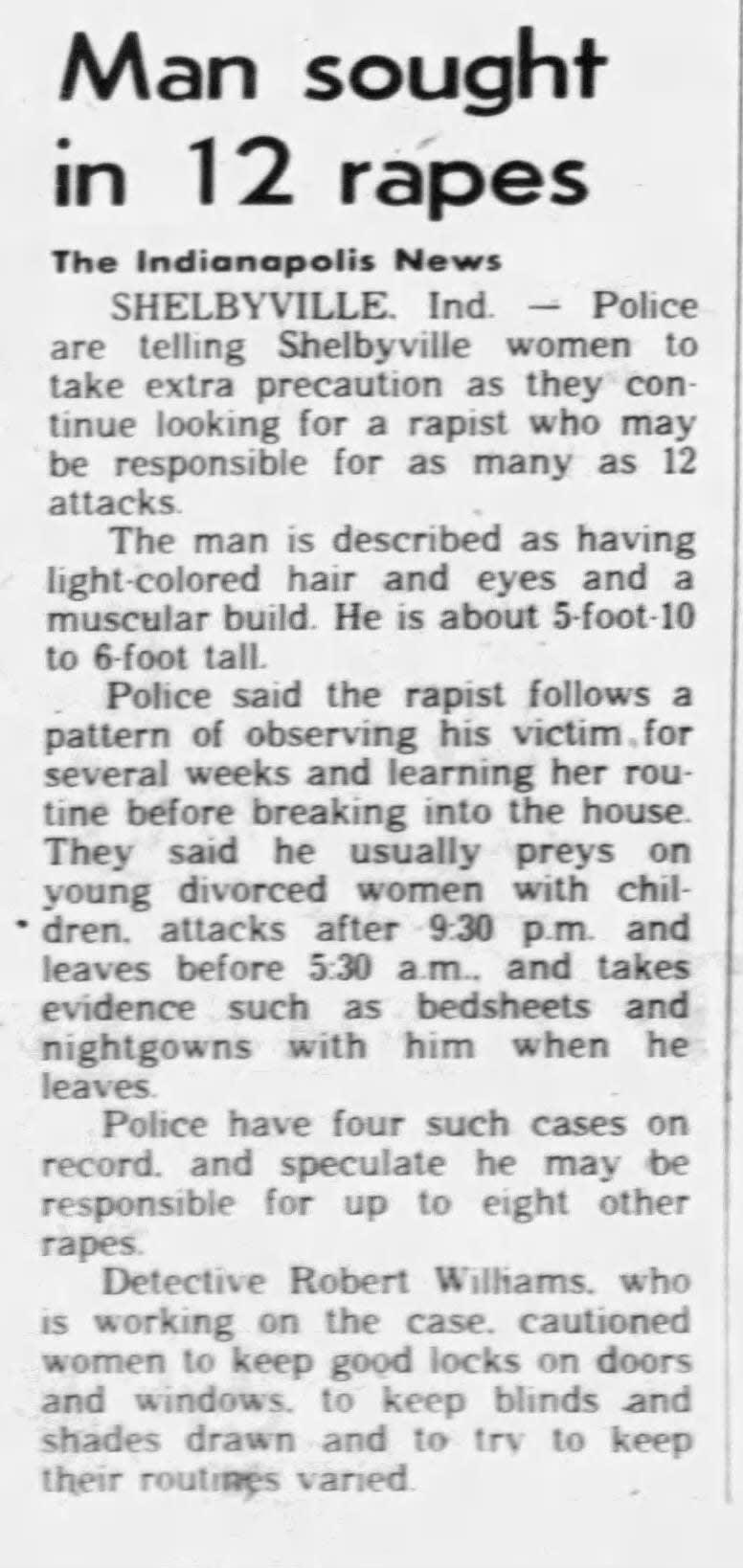'Pure evil': Inside the investigation that led to a 650-year sentence for serial rapist
It's hard to describe the fear that gripped a central Indiana community nearly 40 years ago when a serial rapist was at large: Women were told to alter their routines, gun sales skyrocketed and a local hospital offered shooting lessons.
But the identity of the masked man who broke into Shelbyville homes at night, armed with a knife or a gun, and sexually assaulted women eluded authorities for decades.
It wasn't until 2020 that police identified and arrested Steven Ray Hessler, 59, for the string of sexual assaults after a breakthrough in the case: DNA on a licked envelope for a utility bill payment matched DNA recovered from a 1985 crime scene.
On April 1, Hessler was sentenced to 650 years in prison. After an eight-day trial, he was convicted March 3 of 19 felony charges, including rape, robbery, unlawful deviate conduct and criminal deviate conduct.
"He's just pure evil from the word go. He's definitely a good one to have off the streets," said Shelby County Prosecutor Brad Landwerlen.
Hessler assaulted 10 people in seven separate incidents from Aug. 14, 1982, to Aug. 17, 1985, Landwerlen said. The survivors include a then 16-year-old girl and a former Marine whom Hessler handcuffed, hog-tied and beat with a gun, leaving him in a coma for months.
Hessler forced women to perform sexual acts while threating to harm them and, in some cases, their children if they didn't comply, Landwerlen said. He sometimes administered or talked about enemas during the attacks. In some incidents, he forced men in the home to participate or watch.
"Most were awakened in the middle of the night while they slept," Landwerlen said. "One was in the shower when he pulled the curtain open, just like the movie 'Psycho.'"
Landwerlen described Hessler as a sadist who derived pleasure from "his unnecessarily brutal methods of terrorizing and sexually torturing his victims," noting that the attacks usually lasted three to four hours.
"Steven Ray Hessler is probably the most evil, dangerous, sadistic predator I've ever had the pleasure of prosecuting in my 30-plus career," Landwerlen said.
BryanCook, Hessler's attorney, said his client plans to appeal his conviction. He called into question "several crucial issues" in the case, including "the initial capture of a secondary DNA standard."

Cook said the case involved 80 to 100 suspects, including a cousin of Hessler's who was charged for some of the initial attacks in 1983 and a convict who committed similar crimes in the late 1970s known as the Illinois Enema Bandit.
"Several potentially viable suspects were ruled out by DNA although 8 of 10 victims were not DNA cases – which was a central issue in the case," Cook said in a message. “Many physical descriptions by victims of the attacker did not match Hessler’s age, build, weight, eye color or education.”
'The whole community was shocked'
All but one of the attacks took place in Shelbyville, a community of 20,000 about 30 miles southeast of Indianapolis. The crimes shook the town.
Police advised women in town to take extra precautions, urging them to lock doors and windows, shut their curtains and switch up their routine, the Indianapolis News reported in 1985.

The rapist, authorities said at the time, observed victims for weeks and learned their routines before breaking in their house. The man also preyed upon young divorced women with children.
He wore Levi's blue jeans, a dark nylon jacket, white tennis shoes and a dark stocking mask, the Indianapolis Star reported.
Fearful residents, Landwerlen said, worried about who would be next and whether they would be alive the next day.
"It had the whole place on edge," Landwerlen said. "This was the kind of a case that grabs you and holds you."
People in the town bought guns to protect themselves, and a local hospital started offering shooting courses, Landwerlen said.
"You couldn't hardly buy a gun in Shelbyville," Landwerlen said. "Everybody was buying them up."
The survivors, meanwhile, feared their attacker would make good on his promise to kill them for going to the police.

"They've lived with that constant fear, that recurring fear for years," Landwerlen said.
The attacks in Shelby County stopped in 1985.
Landwerlen said it's not uncommon for people who commit such attacks to stop, pointing out that the Golden State Killer, Joseph James DeAngelo, hadn't killed for decades before his arrest in 2018.
But Landwerlen isn't so sure the rapist quit entirely, mentioning the possibility that he might have committed crimes elsewhere.
"I'm not ready to step forward and declare that he did stop," Landwerlen said. "But these kinds of attacks did stop in Shelby County."
Cracking the case
The masked rapist had carefully covered his tracks, wiping down the crime scenes and taking things he had touched. But eventually, he slipped up.
On Aug. 17, 1985, police collected DNA at the scene of the last known assault in the county but couldn't link it to a suspect.
Hessler had been convicted of rape in a neighboring county and spent most of the 1990s in prison. But he was released about two months before inmates were required to submit DNA samples, Landwerlen said.
Investigators connected Hessler to the crimes after sending DNA samples to Parabon NanoLabs, a company that combines DNA and genealogy testing similar to what led to the Golden State Killer's capture.
Clothing, hair, DNA and technology: How police identified the 'I-65 killer' after 35 years

"They came back with two names that they would suggest that we look at. They were both in the same family," Landwerlen said. "And one of them was Steven Hessler."
The lab's identification led investigators to "start watching these two people," Landwerlen said.
Police learned Hessler paid his water bill through the mail and obtained an envelope he used to send payment. The DNA extracted from the envelope matched the DNA collected back in 1985.
Authorities later obtained another DNA sample from the inside of Hessler's cheek, confirming the link, Landwerlen said.
On Aug. 17, 2020, police entered Hessler's home in Greensburg, Indiana, early in the morning with a search warrant. There, they found photographs that had been stolen from the victims, coats the survivors had described, ski masks, knives, handcuffs and zip ties.
When investigators searched his computers, they found that he had looked up victims whose names had not been disclosed to the public and tracked them, Landwerlen said. He had downloaded an image of the front of the house in Georgia where one of the survivors lived.
"There's no way anyone would know to look up some of these victims," Landwerlen said.
Landwerlen credited the survivors for testifying about their ordeals during the trial, including several who were present at the sentencing hearing.
"They all talked about what a weight has been lifted off," Landwerlen said.
More exclusive coverage for USA TODAY subscribers
Was soldier 'run out' of Army?: An Army specialist accused a superior of rape. She was discharged. Then, her family found her dead.
'Family, family, family': Valerie Biden Owens defends brother 'Joey' and nephew Hunter
'Profiteering, cold-hearted': Nursing home owners should be investigated, congressman says
CAR-T cell therapy: Revolutionary leukemia treatment offers 'a hopeful moment' in fight against solid tumors
What keeps scientists up at night: The world is 'perilously close' to tipping points of irreversible climate change.
This article originally appeared on USA TODAY: How Steven Ray Hessler got 650 years for Shelbyville, Ind serial rapes
